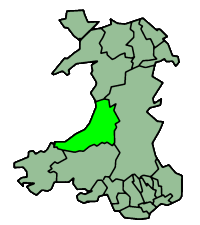- For other uses please see Ceredigion (disambiguation)

| |
| Geography | |
| Area - Total - % Water |
Ranked 4th 1,795 km² ? % |
|---|---|
| Admin HQ | Aberaeron |
| ISO 3166-2 | GB-CGN |
| ONS code | 00NQ |
| Demographics | |
| Population: - () - Density |
Ranked Ranked / km² |
| Ethnicity | 99.5% White |
| Welsh language - Any skills |
Ranked 4th 61.2% |
| Politics | |
| Ceredigion County Council http://www.ceredigion.gov.uk/ | |
| Control | |
| MP | |
| AMs |
|
| MEPs | Wales |
Cardiganshire (Welsh: Sir Aberteifi) or Ceredigion is a county and principal area in western Wales.
Cardiganshire was created in 1282 under the Statute of Rhuddlan, and is considered one of the thirteen historic Welsh counties. More recently, it was abolished as an administrative county in 1974, becoming the Ceredigion district of Dyfed under the Local Government Act 1972. Cardiganshire was restored as a local government county on April 1, 1996, immediately changing its name back to Ceredigion.
History
editIn 1282 Edward I conquered the principality of Wales and divided the area into counties. The name Cardigan was an anglicization of the name for the historic kingdom of Ceredigion.
The name Ceredigion means 'Land of Ceredig', who was a son of Cunedda, a chieftain who re-conquered much of Wales from the Irish around the 5th Century CE.
Geography
editCeredigion is a maritime county bounded to the west by Cardigan Bay, to the north by Merionethshire or Gwynedd, to the east by Montgomeryshire, Radnorshire and Brecknockshire (all in Powys), and to the south by Carmarthenshire and Pembrokeshire.
Its area is 440,630 acres (1783 km²). The population of the county is around 64,000.
The Cambrian Mountains cover much of the east of the county; this large area forms part of the desert of Wales. In the south and west the surface is less elevated. The highest point is Plynlimon at 2,486 feet (758 m), where five rivers have their source: the Severn, the Wye, the Dulas, the Llyfnant and River Rheidol, the last of which meets the Afon Mynach in a 300 foot (100 m) plunge at the Devil's Bridge chasm. The 50 miles (80 km) of coastline has many sandy beaches.
The largest river is the River Teifi which forms the border with Carmarthenshire and Pembrokeshire for part of its length. Other significant rivers include the River Aeron which has its estuary at Aberaeron, the River Ystwyth and the River Rheidol both of which reach the sea in Aberystwyth harbour.
The main towns are Aberaeron, Aberystwyth, Cardigan, Lampeter, New Quay, Newcastle Emlyn (partly in Carmarthenshire) and Tregaron. Tourism and agriculture, chiefly hill farming, are the most important industries.
The main towns are Aberaeron, Aberarth, Aberystwyth, Cardigan, Lampeter, Llanddewi Brefi, Llandysul, Llanilar, Llanrhystud, New Quay, Newcastle Emlyn (partly in Carmarthenshire) and Tregaron.
For a county of such a small population, it may be considered unusual that two universities are within the county boundaries: the University of Wales, Aberystwyth and the University of Wales, Lampeter. The National Library of Wales, which was founded in 1907, is also located in the county.
Government
edit- see also: Ceredigion County Council
Cardiganshire's county council took over the functions of county administration from the Quarter Sessions court in 1889. It was abolished 1974 by the Local Government Act 1972 — and it was succeeded by the district of Ceredigion in the new county of Dyfed. This district was split out in 1996 as a unitary authority, and has (bar minor realignments) identical borders to traditional Cardiganshire. The new county was created under the name Cardiganshire, but in one of its first actions, on April 2, 1996, the council made a resolution to change the name of the county to Ceredigion.
A referendum was held on May 20, 2004 on whether to have a directly-elected mayor for the county; this was rejected by a large majority.
Places of interest
edit- Aberystwyth Castle
- Aberystwyth Electric Cliff Railway,
- Ceredigion Museum, Aberystwyth - grid reference SN5881
- Devil's Bridge - grid reference SN740770
- Llywernog Silver Lead Mine
- Nanteos Mansion
- Strata Florida Abbey - grid reference SN7465
- Vale of Rheidol Railway - grid reference SN7465
- Welsh Gold Centre Tregaron
Culture and society
editCeredigion has a very high proportion of Welsh speakers in the population, only Gwynedd and Anglesey have a higher proportion.
The populace of Cerdigion are affectionately or dispargingly known as Cardis in other parts of Wales, especially in South Wales and they tend to be the butt of some jokes.